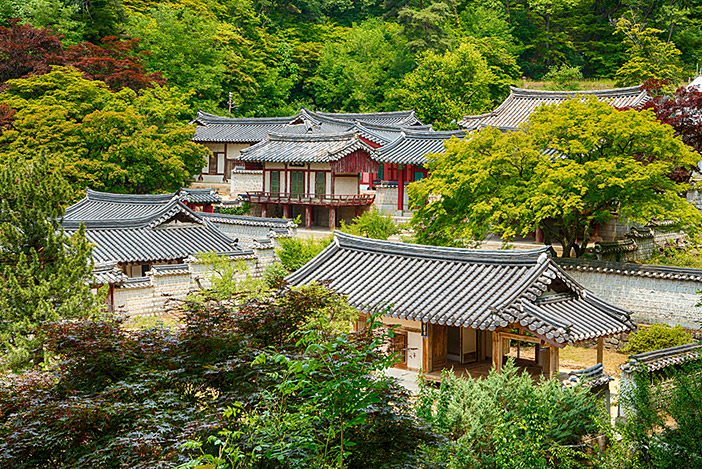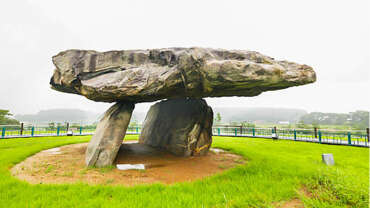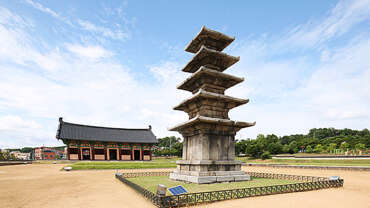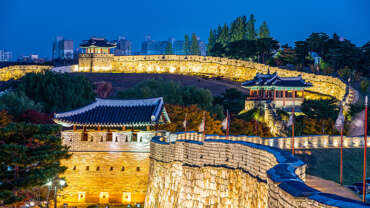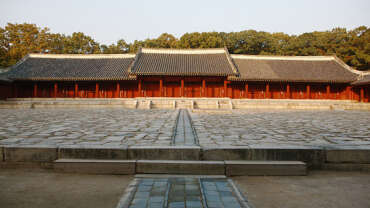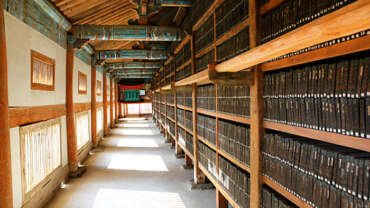Ganghwado Island in South Korea
Ganghwado Island
“Walking in the Kingdom-!
Along the western coast of Korea, about 60 km northwest of Seoul, is an island called “Ganghwado.” Compared to the capital Seoul, which is a major metropolitan area and the political and economic center of Korea, Ganghwado is a small and quaint island only an hour away. At low tide, the western and southern coasts of the island have exposed mudflats that have been recognized as one of the 5 major mudflats in the world. This extensive mudflat is home to black-faced spoonbills, a globally endangered species.
Map of late 19th century Ganghwado Island (owned by the Seoul National University Library)On the southern end of the island is Manisan Mountain, where Dangun, the legendary founder of the first kingdom of Korea, is said to have settled and held offerings to the heavens some five thousand years ago. Up on the northern part of the island is the Gwanghwa Dolmen Site, which has been enlisted on the UNESCO World Heritage list. Among them, the dolmen in the Bugeun-ri area of Ganghwado is considered the “best looking”. Ganghwado is a beautiful island with great mountains, blue oceans, vast fields and much more.
From 1232 to 1270, the capital of Goryeo was moved to Ganghwado in order to resist Mongolian invasion. Traces of the Goryeo Palace still remain to this day. Wouldn’t you like to see what the royal palace looked like? Or see what life was like in those days?
Ganghwado Island is home to numerous historic and cultural places such as the Oegyujanggak (Royal Library of the Joseon Dynasty), which houses books related to the royal family; the hanok (traditional Korean residence) style catholic church built by a British missionary; and a factory that used to produce cotton fabrics.
RECOMMENDED TOUR COURSES
1.The Prince’s Day Out
The prince’s day started at the palace, where he spent most of his time, then he would have enjoyed a delicious meal made using water drawn from Wangjajeong Well. Next he would have gone to Gwanghwasanseong Fortress, which was constructed to fight against Mongolian invasion, to enjoy a drink of water at the Oeup Mineral Spring located passed the fortress’s north gate then admire the view at Bukjangdae Command Post up north.
Goryeo Palace Site –> Wangjajeong Restaurant –> North Gate of Ganghwasanseong Fortress –> Oeup Mineral Spring or Bukjangdae Command Post
2. For the First Time in Korea
Ganghwa Anglican Church was the first Catholic Church in Korea constructed in hanok (traditional Korean residence)-style on November of 1900. Utjangteo (meaning the upper market and currently the parking lot of Jungang Market) was where Korea’s Declaration of Independence Movement started on March 1, 1919. Joyang Bangjik was the first textile factory of Korea built in 1933, and today it has been transformed into a café.
Ganghwa Anglican Church –> Ganghwa Tourism Platform (Jungang Market Building B) –> Joyang Bangjik
3. Workmanship of the People of Ganghwado
Uigwe are books where major events of the royal palace are recorded, and in order to best-preserve the historic, documentary and unique values of the book, it was stored at Oegyujanggak. The Oegyujanggak was the royal library is greatly valued for its historic and scientific properties.
The Sochang (woven cotton) Fabric Experience enter displays the process of making sochang cotton (“Ganghwa silk”). At the South Gate of Ganghwasanseong Fortress, visitors can see geuraengi construction technique (maintaining the shape of the foundation rocks) on the fortress walls. And last but not least, visitors can look around and purchase hwamunseok (woven sedge mats) and kkotsamhap (set of three woven baskets) at the Ganghwa Folk Market.
Oegyujanggak –> Sochang Fabric Experience Center –> South Gate of Ganghwasanseong Fortress –> Folk Flea Market
Goryeo Palace, a Royal Palace That Resembles a Peony Blossom
On a warm, blooming spring day, the first son of King Gojong*, the 23rd king of Goryeo Kingdom (A.D. 918-1392), was born in the capital Gaegyeong. Everybody in the place loved the baby prince, and laughter filled the palace. One day, the Mongol army invaded Goryeo from the north. The Mongol kingdom built by Genghis Khan rapidly grew into a large, powerful force. The Mongol army was so notorious for devasting the entire cities and villages they attacked that those who faced the army had only two choices: death or surrender. In 1232, the Goryeo Kingdom rapidly moved the capital to Ganghwado Island, and King Gojong, Prince Sik and 100,000 households evacuated to the island within 20 days. Surrounded by the sea, the island was a natural fortress since Mongolians, who were born and raised on grasslands, feared the sea.
Prince Sik led the Goryeo army along with a group of young people mobilized from across the country, and they worked day and night to build Goryeo Palace in two years. They built Seungpyeongmun Gate (the south gate of the palace) next to a large courtyard. Seongyeongjeon Hall (the principal office of the king ) and Yeongyeonggung Palace (the main building) stood behind UIbongmun Gate. Among the 14 attached buildings including Ganganjeon Hall, Yeongsujeon Hall, and Gyeongryeongjeon Hall, Sanhojeong Garden located on the backside of the palace was Sik’s favorite place in the palace.
He grew many peonies in the garden so that it resembled the backyard of the royal residence in Gaegyeong. His father said that the peony symbolized the wealth, honor, and dignity of a prince. Sik missed Gaegyeong when he saw the peonies in the garden along with his father. He hoped that the battle with the Mongols would end soon.
However, the war continued for more than 30 years. The Mongol army’s pressure on Goryeo intensified, the Goryeo subjects suffered, and Sik’s father King Gojong became old and feeble. Sik visited the king of Mongol to end the long and tedious fight. However, his father died while he was in Mongol. Sik hurriedly returned to Goryeo Palace on Ganghwado Island and ascended the throne as King Wonjong*, the 24th King of Goryeo. The Goryeo Kingdom had to remove entire facilities that were built to fight against Mongol, in return for maintaining Goryeo’s name and system. In 1270, before leaving Ganghwado Island, which was the capital of the kingdom for 39 years, Sik (now King Wonjong) had to burn down Goryeo Palace the place where he spent his youth. The fire engulfed the palace for several days and nights. As he watched the palace burn to ashes, Sik shed tears of blood. Would this be the end of Goryeo Palace?
*The titles Gojong and Wonjong: In ancient Korea, when a king died, civil servants gave him a temple name and enshrined the king’s ancestral tablet in Jongmyo Shrine. The kings were called different names when they were alive, but here we use the temple names Gojong and Wonjong to help readers understand the story with ease.
Sochang Experience Center & Joyang Bangjik—The Sound of Weaving Sochang Cotton Echoing Across the Island
A girl named Sunja was living in the northern part of Ganghwado Island. Every morning, she went to the sochang cotton factory to work. Sochang, also called Ganghwa silk, is a type of cotton that is commonly used for baby diapers or blanket linings. Sunja was skilled with her hands like her mother, who was good at weaving hwamunseok (rush) mat.
So when a textile manufacturing technician named Ma Jin-su opened the Pyeonghwajikmul factory to make sochang cotton, he asked Sunja to work for his factory. Making sochang cotton required a lot of work. Once you produce yarn, you need to bleach, starch and then dry it.
Dried threads are wound on the spool, and then they are weaved into sochang cotton cloths. Sunja liked it when she saw a bunch of starched threads hung out on long poles outdoors. She thought the threads flapping in the wind looked like noodles. Sochang cotton cloths were very popular and sold like hotcakes. There were several sochang factories other than Pyeonghwajikmul. The very first sochang factory was Joyangbangjik.
It is said the electricity and landline supplies were brought to the island thanks to the operation of Joyangbangjik. Another factory called Simdojikmul opened in 1947 and hired as many as 1,200 workers. Every year, a competition was held among more than 60 sochang cotton factories on the island, and Sunja won the competition for three consecutive years earning the nickname “Miss Sochang.” Sunja was so proud of the title. Ganghwado Island was known for the best quality cotton in Korea, therefore the best on Ganghawdo meant the best in the country.
Ganghwado Island has more than 800 years of fabric manufacturing history. It dates back to the 13th century when the Goryeo Kingdom relocated its capital to the island. Local residents on the island worked day and night to weave textiles and hwamunseok mat (a local specialty of Ganghwado Island). Due to the superb quality of these local items, they were also popular in neighboring countries as well. Thanks to the sochang cotton industry, the island’s population reached 100,000, and sochang cotton was even exported to the US and China. Every morning and evening, the streets near the sochang factories were crowded with commuter vehicles that the factory workers used. Nearby alleys were filled with saunas and inns since factory workers frequently visited saunas to wash away dust and thread, some workers even stayed in the inns as long-term guests. However, as artificial fabrics like nylon were introduced and modern-style textile factories flourished in Daegu, the sochang cotton factories on Ganghwado Island closed their doors one by one and the closed factories were left neglected.
Decades later, the sound of construction filled the air in the area again. Pyeonghwabangjik factory, where Sunja had worked, and the company house transformed into the Sochang Fabric Experience Center. In addition, Joyangbangjik factory where Sunja’s cousin had worked became a café. Long workbenches turned into coffee tables and the walls that had almost collapsed were renovated into a gallery space. Nowadays, people visit the cotton factory-turned café to chat over coffee and cake while sitting in front of the workbenches. Sunja’s youth revived, and the sochang cotton factory was born again.
Yongheungung, House, Where a Woodcutter Became a King
One day in August of 1849, Wonbeom, a 19-year old woodcutter living on Ganghwado Island was resting on a hillside with his jige (Korean A-frame) laid next to him. He saw people moving around together and speaking loudly. They were saying that a huge number of people came from Hanyang, the capital of the Joseon Dynasty. Then he saw a long line of people standing down in the village and he guessed that they must have been the ones from Hanyang. Approximately 500 people including civil and military officers, civil servants from the royal palace, and the military arrived at Ganghwado Island by ship. They passed the Jinhaeru Fortress Gate near Gapgot Naru Wharf and then the South Gate of Ganghwasanseong Fortress.
People on the island had never seen such a grand sight like this before, so everyone was standing on the street to watch the procession. Led by the geumgunbyeoljang (the leader of the royal bodyguard), the procession included the yeongdojang (who led the guard of honor), honor guard flags, the gyoryong-gi flag signaling a royal procession, followed by a royal palanquin. Does this mean the king has arrived on Ganghwado Island? “No, it can’t be,” thought Wonbeom. He had heard that the previous king, King Heonjong, had passed away without a son so there was no king in the country. Wonbeom left his spot and wondered what happened.
But then, Wonbeom heard that the people from Hanyang was looking for him. He got scared and tried to run away to the mountains, without knowing why he is being sought after. But he couldn’t run fast enough with his shaky hands and trembling legs. Then suddenly, a person wearing a nice uniform knelt down politely in front of Wonbeom and told him that he was the grandson of Euneongun, the half-brother of King Jeongjo (the 22nd King of the Joseon Dynasty). Does this mean that Wombeom is of royal blood? Euneongun was involved in a conspiracy, and his family had fallen apart since then. Wonbeom’s father, Jeongyedaewongun, fled to Ganghwdo Island living under a different name and died when Wonbeom was 11. Wonbeom and his elder brother earned a living by cutting and selling trees. The family lived in hiding so he never even learn how to read. But now it turns out that Wombeon would be the next king! At last, he stepped onto the royal palanquin. The 47-km procession that took Wonbeom to Hanyang was such a grandeur that all the people lined up near the path to see it. Wonbeom (1831-1863, reigned 1849-1863) later became King Cheoljong (the 25th King of the Joseon Dynasty). The thatched house he used to live in was remodeled into a tiled roof house and was named Yongheunggung, meaning a house where a dragon prospered. In the past, the dragon was the symbol of a king, so the Yongheunggung House meant a house where a king was born.



